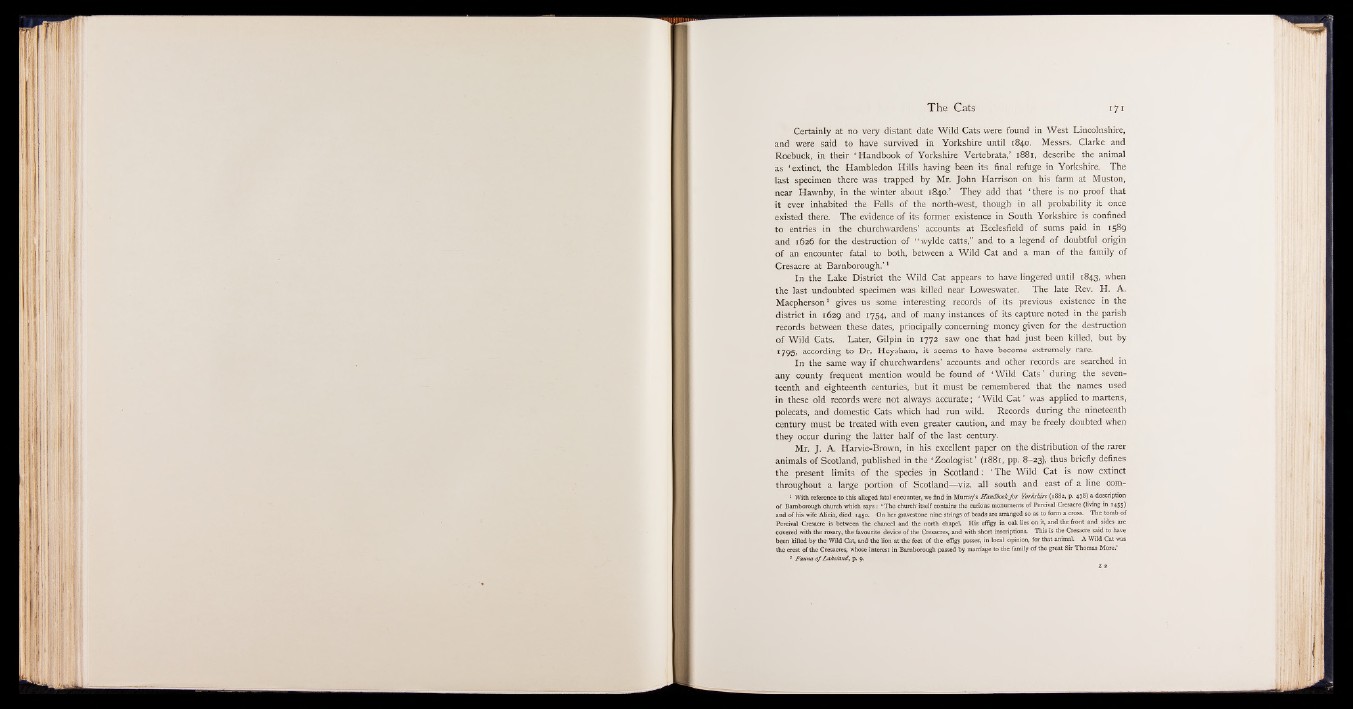
Certainly at no very distant date Wild Cats were found in West Lincolnshire,
and were said to have survived in Yorkshire until 1840. Messrs. Clarke and
Roebuck, in their ‘ Handbook of Yorkshire Vertebrata,’ 1881, describe the animal
as ‘ extinct, the Hambledon Hills having been its final refuge in Yorkshire. The
last specimen there was trapped by Mr. John Harrison on his farm at Muston,
near Hawnby, in the winter about 1840.’ They add that ‘ there is no proof that
it ever inhabited the Fells of the north-west, though in all probability it once
existed there. The evidence of its former existence in South Yorkshire is confined
to entries in the churchwardens’ accounts at Ecclesfield of sums paid in 1589
and 1626 for the destruction of “ wylde catts,” and to a legend of doubtful origin
of an encounter fatal to both, between a Wild Cat and a man of the family of
Cresacre at Barnborough.’ 1
In the Lake District the Wild Cat appears to have lingered until 1843, when
the last undoubted specimen was killed near Loweswater. The late Rev. H. A.
Macpherson2 gives us some interesting records of its previous existence in the
district in 1629 and 1754, and of many instances of its capture noted in the parish
records between these dates, principally concerning money given for the destruction
of Wild Cats. Later, Gilpin in 1772 saw one that had just been killed, but by
1795, according to Dr. Heysham, it seems to have become extremely rare.
In the same way if churchwardens’ accounts and other records are searched in
any county frequent mention would be found of ‘ Wild Cats ’ during the seventeenth
and eighteenth centuries, but it must be remembered that the names used
in these old records were not always accurate; ‘ Wild Cat ’ was applied to martens,
polecats, and domestic Cats which had run wild. Records during the nineteenth
century must be treated with even greater caution, and may be freely doubted when
they occur during the latter half of the last century.
Mr. J. A. Harvie-Brown, in his excellent paper on the distribution of the rarer
animals of Scotland, published in the ‘ Zoologist’ (1881, pp. 8-23), thus briefly defines
the present limits of the species in Scotland: ‘ The Wild Cat is now extinct
throughout a large portion of Scotland—viz. all south and east of a line com-
1 With reference to this alleged fatal encounter, we find in Murray’s Handbook fo r Yorkshire (1882, p. 478) a description
of Barnborough church which says : ‘ The church'itself contains the curious monuments of Percival Cresacre (living in 1455)
and of his wife Alicia, died 1450. On her gravestone nine strings of beads are arranged so as to form a cross. The tomb of
Percival Cresacre is between the chancel and the north chapel. His effigy in oak lies on it, and the front and sides are
covered with the rosary, the favourite device of the Cresacres, and with short inscriptions. This is the Cresacre said to have
been killed by the Wild Cat, and the lion at the feet of the effigy passes, in local opinion, for that animal. A Wild Cat was
the crest of the Cresacres, whose interest in Barnborough passed by marriage to the family o f the great Sir Thomas More.’
1 Fauna o f Lakeland, p. 9.